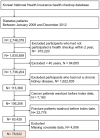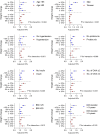Weight change and fracture risk in patients with diabetic kidney disease: A nationwide population-based study
- PMID: 35966851
- PMCID: PMC9366468
- DOI: 10.3389/fmed.2022.912152
Weight change and fracture risk in patients with diabetic kidney disease: A nationwide population-based study
Abstract
Background: The increased risk of fracture has been associated with weight loss in patients with diabetes or chronic kidney disease. However, the relationship between weight changes over time and fracture risk in patients with diabetic kidney disease is still unknown.
Methods: A total number of 78,922 patients with diabetic kidney disease, aged ≥ 40 years, were selected using the Korean National Health Insurance Service database, between 2009 and 2012. They were followed up until the end of 2018. Weight change was defined as the difference in body weight from the index year to 2 years later. Weight changes were then divided into five categories, ranging from weight loss of ≥10% to weight gain of ≥10%.
Results: Fractures were identified in 9,847 patients with diabetic kidney disease, over a median follow-up of 5.2 years. The risk of composite fracture of the vertebral, hip, or other sites increased as the weight change increased. Specifically, patients with ≥10% weight loss (hazard ratio [HR], 1.286; 95% confidence interval [CI], 1.184-1.398) and ≥10% weight gain (HR, 1.198; 95% CI, 1.080-1.330) showed a higher HR compared to those with ≤ 5% weight change after adjusting for several confounding factors. Higher HR of vertebral and hip fractures was also seen with increased weight loss or gain. In particular, patients with ≥10% weight loss showed the highest HR for hip fractures (HR, 1.738; 95% CI, 1.489-2.028).
Conclusions: Both weight loss and weight gain increase the risk of fracture in patients with diabetic kidney disease. Therefore, patients with diabetic kidney disease who experience weight changes should be made aware of the risk of fracture.
Keywords: diabetes; fracture; kidney disease; national health programs; weight.
Copyright © 2022 Kim, Choi, Bae, Ma, Kim, Han and Kim.
Conflict of interest statement
The authors declare that the research was conducted in the absence of any commercial or financial relationships that could be construed as a potential conflict of interest.
Figures


Similar articles
-
Weight change and the risk of hip fractures in patients with type 2 diabetes: a nationwide cohort study.Osteoporos Int. 2022 Aug;33(8):1755-1767. doi: 10.1007/s00198-022-06398-8. Epub 2022 Apr 19. Osteoporos Int. 2022. PMID: 35438308
-
Weight change and microvascular outcomes in patients with new-onset diabetes: a nationwide cohort study.Korean J Intern Med. 2021 Jul;36(4):932-941. doi: 10.3904/kjim.2020.121. Epub 2021 May 13. Korean J Intern Med. 2021. PMID: 32872746 Free PMC article.
-
Weight change and risk of depression in patients with diabetic kidney disease: a nationwide population-based study.Kidney Res Clin Pract. 2023 Jan;42(1):86-97. doi: 10.23876/j.krcp.21.294. Epub 2022 Sep 8. Kidney Res Clin Pract. 2023. PMID: 36328992 Free PMC article.
-
Increased risk of hip fractures in Korean patients with type 2 diabetes: a 6-year nationwide population-based study.J Bone Miner Metab. 2017 Nov;35(6):623-629. doi: 10.1007/s00774-016-0798-z. Epub 2016 Nov 21. J Bone Miner Metab. 2017. PMID: 27873075
-
Mortality and morbidity in patients with osteogenesis imperfecta in Denmark.Dan Med J. 2018 Apr;65(4):B5454. Dan Med J. 2018. PMID: 29619932 Review.
References
LinkOut - more resources
Full Text Sources

